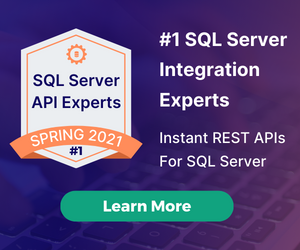5 Critical Mistakes to Avoid When Migrating from .NET MVC to React Apps
by Kevin Hood • November 21, 2025
Modernizing legacy .NET MVC applications? Learn how to avoid common pitfalls when building React apps from a .NET environment
Introduction
Migrating from legacy .NET MVC applications to modern React single-page applications (SPAs) is a common challenge for enterprise development teams. Whether you're working with ASP.NET MVC, .NET Core MVC, or classic ASP.NET, the transition to a React frontend with REST API backend requires careful planning.
This guide covers the five most critical mistakes teams make during .NET MVC to React migration, with special focus on SQL Server database integration, stored procedure management, and REST API design patterns. We'll also show you how API generation platforms like DreamFactory can accelerate your migration timeline from months to weeks.
The 5 Migration Mistakes
When migrating from an old .NET MVC application with SQL Server to a React App, here are the five critical mistakes to avoid:
1. Designing Your REST API as a 1:1 Mirror of Old MVC Controllers
The Problem:
Old .NET MVC apps had controllers that returned complete views with all data pre-loaded. The mistake? Creating REST endpoints that exactly replicate these monolithic controller actions (like /api/CustomerDetails that returns everything).
The Solution:
Design resource-oriented REST endpoints (/api/customers/{id}, /api/orders) that are composable and reusable. Think resources and HTTP verbs, not page-by-page data dumps. Your React app makes 2-3 focused API calls instead of one bloated endpoint—resulting in better performance and maintainability.
2. Blindly Wrapping Existing SQL Server Stored Procedures
The Problem:
Your legacy SQL Server database likely has hundreds of stored procedures written years ago with poor performance—missing indexes, SELECT *, unnecessary joins, or cursors. Simply wrapping these in REST endpoints carries forward all these problems.
The Solution:
Audit stored procedures before migration. Use SQL Server's query store to find the slowest ones. Consider rewriting them as optimized LINQ queries or breaking monolithic sprocs into focused operations. Add proper indexes based on your new API patterns. Remember: 20% of your stored procedures likely handle 80% of traffic—focus there first.
3. Failing to Address the N+1 Query Problem in REST APIs
The Problem:
When React needs a customer with orders, addresses, and payment methods, you end up making one call to /api/customers/123, then N calls to /api/orders?customerId=123 for each order, plus more calls for related data. With legacy databases spanning 5-10 tables per relationship, this becomes catastrophic.
The Solution:
Create strategic composite endpoints like /api/customers/123?include=orders,addresses that return nested data with efficient JOINs. Use SQL profiling to ensure you're not generating hundreds of individual queries. Consider database views or indexed views for common access patterns. The goal: minimize round trips while keeping queries optimized.
4. Maintaining Cookie-Based Authentication Without Proper CORS Configuration
The Problem:
.NET MVC relied on Forms Authentication with server-side sessions in cookies. With a React SPA calling REST APIs (especially across different domains/ports during development), you'll hit CORS issues and session management nightmares.
The Solution:
Implement JWT token-based authentication—it's stateless and perfect for SPAs. Store refresh tokens in httpOnly cookies and access tokens in memory. Configure CORS properly for your development and production environments. Each API request becomes self-contained with the JWT, eliminating session state complexity.
5. Ignoring SQL Server Performance Issues During Migration
The Problem:
Legacy SQL Server databases often have missing indexes, fragmented data, and outdated statistics. In MVC apps, you could hide this with server-side caching or accept slow page loads. In React SPAs, users expect instant responses—every API call shows a loading spinner.
The Solution:
Implement pagination from day one (?page=1&pageSize=50) and never allow unlimited result sets. Push filtering and sorting to the database, not your API layer. Use SQL Server's missing index DMVs to identify needed indexes. Implement multi-level caching (Redis for frequently accessed data, HTTP cache headers for clients). Set performance budgets—no endpoint over 200ms. For complex schemas, consider CQRS patterns with denormalized read models.
Key insight: That 200-table legacy database is your biggest migration risk. Don't treat it as a black box—a chatty REST API + unoptimized database = performance disaster.
How DreamFactory Addresses These Migration Challenges
Accelerate Your .NET MVC to React Migration
We've worked with numerous enterprise customers modernizing their .NET MVC applications, including healthcare technology companies, government agencies, and more. Their common challenges include:
- Large, complex SQL Server stored procedures causing performance bottlenecks
- Hundreds of database tables with unclear relationships
- Difficulty maintaining and refactoring legacy database code
- Vendor lock-in to specific database platforms
- Lengthy API development timelines delaying React app releases
DreamFactory's automated REST API generation platform addresses each of these challenges:
Mistake #1: Poor API Design → DreamFactory's Resource-Oriented Auto-Generated APIs
Instead of manually creating REST endpoints that mirror your old MVC controllers, DreamFactory automatically generates standardized, resource-oriented REST APIs directly from your SQL Server database schema.
What you get:
- Properly structured endpoints: GET /api/v2/{service_name}/_table/{table_name}/{id}
- REST best practices with correct HTTP verbs
- Instant API consumption for your React app
- No temptation to replicate bad architectural patterns
Result: Minutes to API generation vs. weeks of manual coding.
Mistake #2: Stored Procedure Hell → DreamFactory's Flexible Execution Options
This is where DreamFactory excels for enterprise SQL Server environments with legacy stored procedure dependencies.
Multiple migration strategies:
- Instant exposure: Call existing sprocs via REST (POST /api/v2/{service_name}/_proc/{procedure_name})
- Flexible parameters: Pass params as URL parameters or request body
- Gradual replacement: Create database views DreamFactory exposes as table resources
- Business logic extraction: Use server-side scripting (PHP/Python/Node.js) to make logic database-agnostic
- Performance tracking: Identify slowest sprocs and prioritize refactoring
The advantage: Start React development immediately with existing sprocs, then systematically replace them without changing React code.
Mistake #3: N+1 Queries → DreamFactory's Built-in Related Data Fetching
DreamFactory's relationship discovery and join capabilities eliminate N+1 queries at the API level automatically.
How it works:
- Single call: GET /api/v2/{service_name}/_table/customers/123?related=orders_by_customer_id,addresses_by_customer_id
- Returns nested JSON with all related data using efficient SQL JOINs
- Auto-generates relationship aliases from foreign keys
- Use related=* to fetch all related tables
Advanced features:
- Customize relationship aliases for intuitive naming
- Filter, limit, and select fields on related data
- Create virtual foreign keys between unrelated tables (DataMesh)
Result: Complex data retrieval that required multiple stored procedures now happens in one optimized API call.
Mistake #4: Authentication Chaos → DreamFactory's Enterprise-Grade Auth
DreamFactory includes comprehensive enterprise authentication out of the box:
Authentication Options:
- JWT tokens: Core technology, perfect for stateless React SPAs
- Enterprise SSO: Active Directory, LDAP, SAML 2.0, OpenID Connect
- OAuth 2.0: Auth0, Okta, Azure AD, AWS Cognito, Google, GitHub, Facebook
- CORS: Built-in configuration for seamless React development
Security Features:
- Role-based access control (RBAC) at API, table, and field levels
- API key management per application
- Session token management for authenticated users
- Granular permissions without custom authorization code
Result: Enterprise-grade security configured through the admin interface—no coding required.
Mistake #5: Database Performance Issues → DreamFactory's Optimization Features
DreamFactory provides multiple layers of database performance optimization:
Core Features:
- Pagination: Automatic limit and offset parameters on all endpoints
- Server-side filtering: SQL-like syntax (filter=status='active' AND created_date>2024-01-01)
- Field selection: Retrieve only needed columns (fields=id,name,email)
- Response caching: Redis or file-based caching with TTL and invalidation
- Connection pooling: Efficient database connection management
- Transaction support: Batch operations with rollback=true for data consistency
Performance Impact:
- Prevents unlimited result sets by default
- Reduces payload size through field selection
- Dramatically improves read performance with caching
- Enables query optimization monitoring
Result: Move complex WHERE clauses from stored procedures to parameterized API calls—easier to optimize and monitor.
The Strategic Advantage:
Database Vendor Independence
Perhaps most importantly, DreamFactory eliminates database vendor lock-in. DreamFactory supports 18+ databases:
SQL: MySQL, PostgreSQL, SQL Server, Oracle, IBM DB2, SAP SQL Anywhere, SQLite
NoSQL: MongoDB, DynamoDB, Azure Tables, Cassandra, CouchDB, Couchbase
Cloud: Aurora, Redshift, Azure SQL, CosmosDB, Cloud SQL, Snowflake, Databricks
What this means for you:
- Migrate from SQL Server to PostgreSQL without React code changes
- Test performance across database vendors during POCs
- Implement read replicas behind the same API endpoints
- Mix data sources (SQL + MongoDB) in unified REST APIs
- Escape expensive Enterprise licensing costs
Result: The same DreamFactory configuration works across all databases—just change the connection.
Real Migration Results
Organizations using DreamFactory for .NET MVC to React migrations achieve:
- Faster Time-to-Market: Start building React apps within hours using auto-generated APIs
- Incremental Refactoring: Systematically improve stored procedures without blocking frontend development
- Better Performance: Reduce database query times significantly using caching and query optimization
- Enhanced Security: Implement enterprise authentication and RBAC without custom code
- Cost Savings: Create migration paths away from expensive SQL Server Enterprise licenses
Migration Timeline Comparison:
- Traditional manual REST API development: 3-6 months
- With DreamFactory automated API generation: 2-4 weeks
FAQs
Q: Can DreamFactory work alongside my existing .NET MVC app during migration?
Yes. DreamFactory runs alongside your existing .NET MVC application. Build new React features using DreamFactory APIs while keeping legacy MVC pages running. Both access the same SQL Server database. This "strangler pattern" enables piece-by-piece migration without risky rewrites.
Q: How long does initial setup take?
60 minutes typically. Install DreamFactory, add your SQL Server connection, and APIs are generated instantly. You're testing API calls within the first hour using the built-in Swagger documentation. Compare this to weeks or months of manual .NET Web API development.
Q: Do we need to rewrite hundreds of stored procedures immediately?
No. DreamFactory exposes existing stored procedures as REST endpoints immediately. Your React app calls them like your MVC app did. Identify the slowest 20% (which handle 80% of traffic) and refactor those first. Leave the rest as-is until needed.
Q: Where does our .NET controller business logic go?
Multiple options: (1) Server-side scripts in PHP/Python/Node.js as event handlers, (2) Database views/functions, (3) React components for client logic, or (4) Separate microservices. Most customers use a combination.
Q: How does DreamFactory handle our Active Directory authentication?
DreamFactory integrates with Active Directory, LDAP, OAuth 2.0, OpenID Connect, SAML 2.0, and custom database tables—all configured through the admin interface. React apps receive JWT tokens for API requests. Define role-based access control (RBAC) at the API, table, or column level without writing authorization code.
Q: Our database has 200+ tables with complex relationships. Can DreamFactory handle this?
Yes. DreamFactory analyzes foreign keys and creates relationship aliases automatically. Use ?related=customer_by_customer_id to fetch an order with its customer in one optimized query. For extremely complex schemas, create database views or use DreamFactory's DataMesh feature for virtual foreign keys between unrelated tables.
Q: What's the performance impact of adding DreamFactory?
Minimal overhead per request, but often improves overall performance through caching, connection pooling, and better query patterns. Customers see significant gains when enabling Redis caching. DreamFactory enforces best practices (pagination, field selection, efficient joins) that prevent common anti-patterns.
Q: Can we migrate away from expensive SQL Server licenses?
Yes. Because React talks to DreamFactory APIs (not the database directly), swap SQL Server for PostgreSQL or MySQL by changing the connection—zero React code changes. Many customers run both databases in parallel through DreamFactory during migration, achieving substantial cost savings.
Q: How do we handle database transactions?
Multiple ways: (1) Batch operations with rollback=true parameter, (2) Call transactional stored procedures, (3) Write custom event scripts that wrap operations in transactions, or (4) Rely on database ACID guarantees for individual operations.
Q: Does DreamFactory work in high-traffic production environments?
Yes. Used by Fortune 500 companies and government agencies processing millions of requests daily. DreamFactory is stateless and scales horizontally—add more instances behind a load balancer. Built on Laravel/PHP with proper caching (Redis) and database optimization, it handles enterprise-scale traffic.
Get Started Today
Ready to Accelerate Your .NET MVC to React Migration?
DreamFactory can reduce your migration timeline from months to weeks while ensuring best practices for REST API design, database performance, and enterprise security.
Next Steps:
Schedule a Demo - See how DreamFactory generates REST APIs for your SQL Server database in minutes
Kevin Hood is an accomplished solutions engineer specializing in data analytics and AI, enterprise data governance, data integration, and API-led initiatives.



























